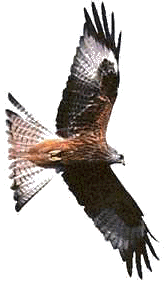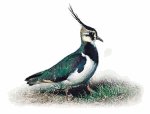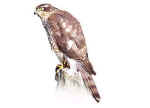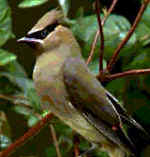
Managed by Brian Clews
 |
Cookham Birdwatch 2001
Managed by Brian Clews |
Latest News:
12 November 2001 - Autumnal Bird Scene
Well, we've had our first taste of frost, and snow was not far away from us last week, so what do the birds make of all of this?
We are pretty much at the end of the migration period for those birds which came to us for the summer. Some Swallows are still lingering on the south coast but had started departing the Cookham area in September. The last of the House Martins were still feeding young in the nest in early October but they too had well gone by the month's end. All the small warblers such as Chiffchaff, Willow Warbler and Whitethroats are already well into their two-month journey to various parts of Africa, along with Blackcaps, which are often the last to depart.
However, it may not be the last you will see of Blackcaps this year. A recent phenomenon has been the over-wintering of this delightful little warbler throughout much of the UK; but it has been shown by ringing schemes that these birds are not the ones which summer with us, but ones which breed in Germany and then flit over to spend winter with us before returning once again to Germany in March/April time. I did a small county survey of garden birdwatchers last winter and found that no less than 42% of participants had recorded Blackcap in their gardens between December and February.
During
the end of October, following the breeding season, many birds replay a little
of their courtship song and be haviour
for a short period. Song Thrushes and Blackbirds were singing
again and Kestrels, Sparrowhawks and larger birds of prey tumble and
dive together in the sky for a few days, as if to say, "well missus, we
did it and all went well". But now they are all getting set for the
winter ahead. And as that season approaches, and the leaves fall from the
trees, the birding scene will change again, with large gatherings of Crows and
Rooks on farmland, with luck accompanied by flocks of Lapwings
returning from their western breeding grounds. We often see flocks of up to
1000 around here, but the vast majority of them are non-breeding adults which,
when they reach they end of their ten-year life, will disappear and not be
replaced by any progeny. For this reason, all the major ornithological bodies
are hosting a special Lapwing monitoring programme over the months
ahead, so if you see any, please do count them and let me know.
haviour
for a short period. Song Thrushes and Blackbirds were singing
again and Kestrels, Sparrowhawks and larger birds of prey tumble and
dive together in the sky for a few days, as if to say, "well missus, we
did it and all went well". But now they are all getting set for the
winter ahead. And as that season approaches, and the leaves fall from the
trees, the birding scene will change again, with large gatherings of Crows and
Rooks on farmland, with luck accompanied by flocks of Lapwings
returning from their western breeding grounds. We often see flocks of up to
1000 around here, but the vast majority of them are non-breeding adults which,
when they reach they end of their ten-year life, will disappear and not be
replaced by any progeny. For this reason, all the major ornithological bodies
are hosting a special Lapwing monitoring programme over the months
ahead, so if you see any, please do count them and let me know.
Inevitably, the winter thrushes will soon be with us in good numbers; you may already have seen the stocky Mistle-thrush-sized Fieldfare or the delightful Redwing with its distinctive eye stripe, but they will increase in numbers throughout the next few weeks, reaching their peak around January. The orchards in Long Lane are a good place to find larger flocks. Huge numbers of gulls may roost on Widbrook when it gets inundated with water nearer Christmas, and if any Grey Partridges have survived the summer, they will be easier to see as vegetation dies down.
In the meantime, unless you have fed your birds during the summer, time to get out, wash and install your feeding stations to help those Blue and Great Tits, House Sparrows and Dunnocks through the winter. Who knows, you may be lucky enough to get Great Spotted Woodpecker, Siskin or Nuthatch on your nut feeders, and those entertaining Blackcaps on the fatballs you can buy from the Garden Shop in the Parade. So, enjoy the birds in your garden and, Eyes to the Skies!
4
May 2001 Well,
Foot and Mouth continues to disrupt normal bird watching activities (though
RSPB Minsmere opened just in time for our coach trip this weekend!). Locally,
many footpaths and woods remain closed but Quarry Wood has now opened
enabling me to check out some of the Tawny Owl boxes we installed last year.
What a thrill to find one with three down-covered chicks inside - a great
result and still a few to check. Last year a Mandarin Duck used one to raise
16 young and there were signs that they used an adjacent one this year too. Widbrook
Common is looking wonderful – just as a marshy piece of common-land should
do. Loads of buttercups and daisies, some real boggy flashes and, for the
first time ion years, Lapwings looking like they might nest there. Amazing
what a bit of freedom from disturbance can achieve, so even if Curly Carver
does open it soon, please keep off the main area and give the Lapwings a
chance – they are one of the rarer breeding birds in the county these
days. Many
resident birds have of course been nesting since March, but the earlier ones
have suffered with cold and wet weather and subsequent lack of food for
young. I suspect many may have perished unfortunately, just like last
spring. however, many will try again so there is still hope. There
has been much controversy this year about feeding of peanuts to birds. Many
deliveries were found to be sub-standard leading to fears about bird safety.
Please do ensure you get yours from a reputable source, and for the summer
months, I suggest you grind them up before putting them out to ensure no
problems with fledglings choking on them. I am finding that many species in
my garden have reverted to the fat balls I buy from Village Hardware (6 for
£1) as they are a source of high-energy food for busy parent birds. Swifts,
Swallows and Sand Martins have been streaming in, but, just like last year,
House Martins seem very slow in arriving. They have been breeding later and
in smaller numbers in recent year so the RSPB have been encouraging folk to
have artificial House Martin nest boxes installed to see if this helps. (I
have some in stock if anyone is interested). Anyway,
good birdwatching for the remainder of spring-time. Do remember to take some
bins with you on any walks you take round the village – you never know
what you might see. (I even take mine when I go shopping, but then I am a
sad case!!)  Most
of the summer visitors are here now. I heard my first Cuckoo in the Dean
this week from my allotment, where a Whitethroat and a Blackcap kept
Chiffchaff and Garden Warbler company. A Goshawk also flew over last
weekend; the second time I have seen it over the village this month. It
looks like a very large Sparrowhawk and has a distinctively damaged tail.
Many raptors are migrating through the country at present and magnificent
Marsh Harrier over-flew the village on Saturday. The same day, a Hen Harrier
was over Bracknell, 2 Osprey over Reading and a Honey Buzzard over Regents
Park. (remember my article about the invasion of them last autumn?)
Most
of the summer visitors are here now. I heard my first Cuckoo in the Dean
this week from my allotment, where a Whitethroat and a Blackcap kept
Chiffchaff and Garden Warbler company. A Goshawk also flew over last
weekend; the second time I have seen it over the village this month. It
looks like a very large Sparrowhawk and has a distinctively damaged tail.
Many raptors are migrating through the country at present and magnificent
Marsh Harrier over-flew the village on Saturday. The same day, a Hen Harrier
was over Bracknell, 2 Osprey over Reading and a Honey Buzzard over Regents
Park. (remember my article about the invasion of them last autumn?)
20 January 2001
We
are just emerging from one of the coldest spells we have had for some time,
with ground solid in frost for several days and little un-frozen water.
These conditions make it extremely hard going for small birds, many of whom
need to eat almost their own weight in food just to survive one night of
such temperatures (unlike us who probably also consumed our own weight in  food over Christmas!!) So
if you normally feed your garden birds, keep it going through these cold
snaps and don't forget to put out fresh water each day. The
cold snap at last sent some Waxwings our way but regrettably, they
were only in the village for one day. Some 2000 or so seem to have
been spread out down the east coast for a few weeks, and there is still time
for some to turn up again. One
of the rarest birds over Cookham recently has been Hawfinch.
Nowadays, a very elusive species to find, usually only feeding on Hornbeam.
One flew over my house in mid December, and Philip Ind saw another (or the
same individual) over Winter Hill more recently.
food over Christmas!!) So
if you normally feed your garden birds, keep it going through these cold
snaps and don't forget to put out fresh water each day. The
cold snap at last sent some Waxwings our way but regrettably, they
were only in the village for one day. Some 2000 or so seem to have
been spread out down the east coast for a few weeks, and there is still time
for some to turn up again. One
of the rarest birds over Cookham recently has been Hawfinch.
Nowadays, a very elusive species to find, usually only feeding on Hornbeam.
One flew over my house in mid December, and Philip Ind saw another (or the
same individual) over Winter Hill more recently.
Last
year, the council sponsored me to have thirty Little Owl boxes
made and installed, so this winter was the first occasion to see how they
had been used. Well, the first two had been stolen! (Still, this is to be
expected in this area I guess). Another had survived the tree it was
attached to falling down in recent gales - it will have to be found a new
home. Two had Great Tit nests in - goodness knows how long it took
them to fill such a large cavity! Some had been taken over by squirrels, in
fact in one box I had to physically eject four squirrels who just would not
come out even with me leering down on them with the lid open! But the good
news is that we found several boxes with obvious Little Owl nest
material, one with abandoned eggs, but which will hopefully be used again
this season, and in two boxes, the Little Owls were sat inside
looking up at me as if to say 'this is mine! Push off and find your own!
Still a few to check, but overall, a very good result for year one!
|
|
|
ARCHIVE BIRDWATCH
|
|
|
|
|
Cookham - It's birds, people & places: A book which looks at the changing face of Cookham over the last century, and the effect this has had on birdlife, with recollections of local villagers and suggestions for exploring this pleasant place. Some of the proceeds will go to Elizabeth House Day Centre, in Cookham. Since initial publication in Dec 97, further copies have been made, an ideal gift for a family member or a friend who once used to live here. |
|
|
|